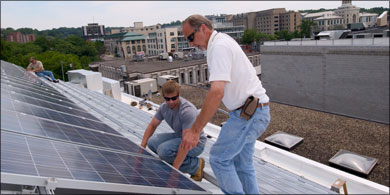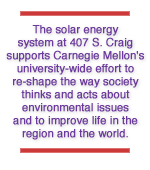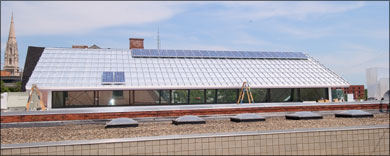|
|
||||
|
|
Solar Energy Helps Power Campus Facility
Cells convert sunlight into electricity at 407 S. Craig Street
Can solar power work in Pittsburgh, where cloudy days outnumber sunny days by five to one? Carnegie Mellon University and its School of Computer Science (SCS) are counting on it.
Thanks to an $88,000 Energy Harvest grant from the Pennsylvania Department of Environmental Protection, the renovation at 407 S. Craig Street, now occupied by members of SCS' Interactive Systems Lab and the Institute for Software Research International, includes a photovoltaic (PV) energy system. A PV energy system, which contains cells made of semiconductor material such as silicon, converts sunlight directly into electricity. This rooftop solar array, one of the largest of its kind in Pittsburgh, feeds directly into the building's main power supply, thus reducing the amount of fossil fuel-based electricity needed.
"You can still get sunburned on a cloudy day," says Brad Hochberg, Carnegie Mellon's Facilities Management Services' energy manager.
On average, the 12-kilowatt-DC solar array system will provide approximately 10 percent of the building's electricity needs. Over the course of a year, that's enough energy to support the more than 80 computers housed in the building. The system also reduces the output of greenhouse gases by more than 31,600 pounds per year.
The solar energy system at 407 S. Craig supports Carnegie Mellon's university-wide effort to re-shape the way society thinks and acts about environmental issues and to improve life in the region and the world.
SCS and Facilities Management Services are working with the university's Green Practices Committee to attain a Leadership in Energy and Environmental Design (LEED) Silver Rating for the facility from the US Green Building Council. If certified, 407 S. Craig will be the university's third structure to be recognized by the US Green Building Council. The Henderson House residence hall earned a silver certification in 2004 and the New House residence hall was honored in 2003. New House was the first university residence hall in the country to be certified as a green dormitory.
In addition to using solar power, 407 S. Craig's air conditioning system uses 100 percent outside-air, compared to the 30 percent used by standard systems. Recycled and energy efficient materials are featured throughout the facility and the large clerestory skylight, on which the solar array sits, increases the amount of natural light into the building.
"Green practices aren't just good for the environment," says Jim Skees, SCS building facilities manager, "they're good for the people in the buildings, too. If you ask the question, 'What does green cost us?' you'll find that it raises the initial cost of a project slightly. However, it's worth it in the long run."
To help educate the public about renewable energy sources, the front window on Craig St. will contain a display, showing passers-by images of the rooftop array as well as graphs and charts detailing how much energy is being produced and the amount of greenhouse gases being avoided.
Energy Harvest grants from the Pennsylvania Department of Environmental Protection leverage private funds to promote advanced energy technologies to generate jobs, improve air quality, preserve land, protect watersheds and enhance energy security.
LeeAnn Baronett |
||
|
Carnegie Mellon Home |
||||

 The amount of energy produced by the system will vary daily, based on the weather, air pollution and the angle of the sun. But even on cloudy days, the array will still produce energy.
The amount of energy produced by the system will vary daily, based on the weather, air pollution and the angle of the sun. But even on cloudy days, the array will still produce energy.

 Hochberg, a member of the university's Green Practices Committee, agrees that projects like this are important for the university. "In order to teach our students to be more environmentally conscious, we need to practice what we preach," he says.
Hochberg, a member of the university's Green Practices Committee, agrees that projects like this are important for the university. "In order to teach our students to be more environmentally conscious, we need to practice what we preach," he says.